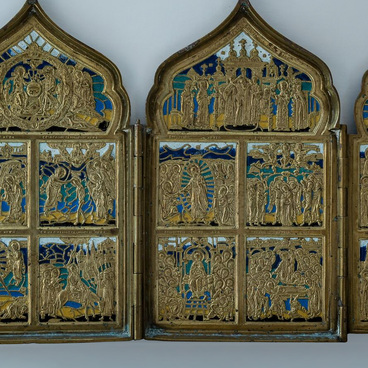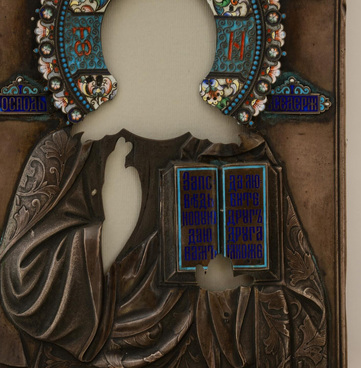In the Middle Ages, the traditional iconographic depiction of the “Crucifixion of Christ” was developed by the addition of those who were with Christ before His death: on the left side — the Virgin Mary and St. Mary Magdalene, on the right — John the Apostle and Longinus, a Roman centurion. This composition is called “The Crucifixion of Christ with Saints.”
From the 18th century, Old Believers cast crosses, icons, and folding icons; however, it was officially prohibited to produce metal images due to their “lack of artistic value”. Old Believers, by virtue of their opposition to the authorities (both secular and spiritual — to the followers of Patriarch Nikon), these prohibitions were ignored and the craft continued to develop. It should be noted that the products of the Old Believers foundries were also bought by the “Nikonians” who were used to keeping (and venerating) both wooden images and metal ones inherited from their ancestors. Therefore, the mere fact of owning such cast images was not necessarily a sign that the image belonged to the Old Believers.
In the 19th century, Russian metalworkers added eighteen selected images to the above-mentioned composition, mostly depicting the Great Feasts (from left to right, from top to bottom): the New Testament Trinity, the Mother of God Hodegetria with selected saints, the Exaltation of the Cross, Candlemas, the Annunciation, Our Lady of the Sign, the Lord’s Entry into Jerusalem, the Resurrection (Harrowing of Hell), the Nativity of Christ, the Epiphany, the Ascension, the Old Testament Trinity, St. Nicholas the Wonderworker, Pentecost, the Presentation of the Virgin, the Transfiguration, the Nativity of the Virgin, and the Dormition of the Virgin.
The complexity of the cast icon “The Crucifixion with Saints and Feasts” is striking. The masters cast familiar images in miniature, conveying inscriptions, robes, faces, characteristic poses and gestures, as well as details of architecture, landscape, and so on.
The background of relief images is blue enamel,
also very skillfully made: it enhances the brightness of relief images. The
contrasting combination of bronze and dark blue enamel background creates a
vivid decorative effect.


